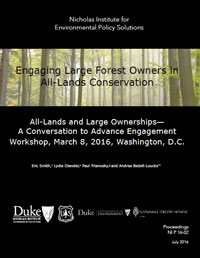Nicholas Institute for Environmental Policy Solutions
Publisher
Successful landscape-scale forest conservation and management efforts must engage a wide variety of forestland owners. Owners of large areas of forestland (more than 10,000 acres) have a particularly important role to play in the attainment of landscape-scale goals. Their cooperation increases opportunities for attaining conservation benefits at significant scale. On March 8, 2016, a group of large private landowners was for the first time brought together with federal, NGO, and academic thought leaders to generate ideas for improving engagement on landscape-scale conservation goals. The dialogue was designed to identify barriers to and options for that engagement. These proceedings summarize the dialogue of meeting participants in addressing an “all lands” approach to conservation whereby landowners and stakeholders collaborate on identifying long-term, mutually beneficial goals for the landscapes they share. It includes a profile of large institutional forestland owners and details the results of a survey conducted to measure their current engagement in conservation activities. Participants identified barriers to engaging large forest landowners in conservation. They include the absence of an inclusive vision for the future of forest management, insufficient leadership for building diverse coalitions to address forest threats, lack of alignment of existing federal programs with respect to large ownership structures, limited understanding of the public benefits provided by large privately owned forests, and lack of markets to sustain these benefits. Participants recognized the need to define a shared conservation vision, to build leadership for a broad coalition of stakeholders, and to execute a national strategy recognizing the value of and providing incentives for large private landowners to cooperatively address forest threats. Much discussion centered on building the business case for conservation and on recognizing new values and expanding markets. Participants also considered opportunities for aligning the incentive-based approaches of funding agencies with the needs and interests of forestland owners. A steering committee was formed to consider developing specific strategies to incentivize engagement of large forestland owners and to work toward a collaborative vision for attaining conservation objectives across varied ownerships.



